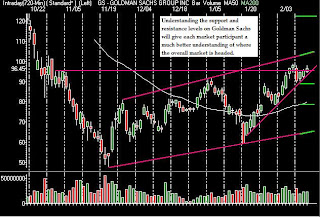Goldman Sachs began its meteoric rise from one of the many financial firms to the one true elite player as Paulson took power. Goldman Sachs quickly gained traction as the market directional leader almost like a blessed being. They could do no wrong, profits soared and even in this major recession and financial crisis, they remain one of the few still standing, still profiting. The charts speak for themselves, many on Wall Street including the Chief Market Strategists at InTheMoneyStocks.com say, “as goes Goldman, so goes the market”. This connection is one of the true symbiotic relationships in the market and can be seen on a daily basis. Should Goldman Sachs begin to break up, the market usually follows and if Goldman starts to collapse, the markets begin to tumble. Many of the pro traders now watch Goldman Sachs as a leading indicator for the market. To explain this symbiotic relationship further, take a look at the chart from February 5th, 2009. Compare the intra day 5 minute SPY chart and the intra day 5 minute GS chart. Note in the chart how Goldman Sachs and the market both gap lower on the day, however, almost immediately Goldman starts to rally higher and go positive. Goldman continues to rally while the markets sell. However, the selling in the markets quickly subsides as Goldman continues higher. The market begins to rally and continues the upward move for the rest of the day. Note the charts below showing Goldman Sachs leading and the market following.


Understanding this relationship means that the Goldman Sachs chart must be scrutinized closely to understand the possible movement in the coming weeks and months in the market. As part of InTheMoneystocks.com, we look purely to the technicals in the charts and avoid all the Wall Street hype that contributed greatly to the financial crisis at hand. This allows us to focus on, and project the true direction of the markets. As we study the charts on Goldman Sachs, there are a few major trend lines that need to be watched closely in the coming days. Should these break, Goldman could see a dramatic move and as we say, where Goldman Sachs goes, the markets will follow.


Understanding that Goldman Sachs leads the market can increase profits. Goldman has some extremely key levels on its horizon and must be watched very carefully. The ultimate downside target should support trend lines not hold would be $80 then possibly a retest of the lower pink trend line from the November lows connecting to the January lows. However, if Goldman Sachs can show some strength here and stay above these key support lines, the target for the next major resistance point is the trend line from the high in November connected to the high in January. If that resistance point is broken, ultimately Goldman will see $120.
Always watch Goldman Sachs as a leading indicator of the market. Should it begin to break up or down through key supports or resistance levels, the market is sure to follow. Remember, the charts tell the truth.
Source: InTheMoneyStocks.com The Leader In Market Technical Guidance

No comments:
Post a Comment